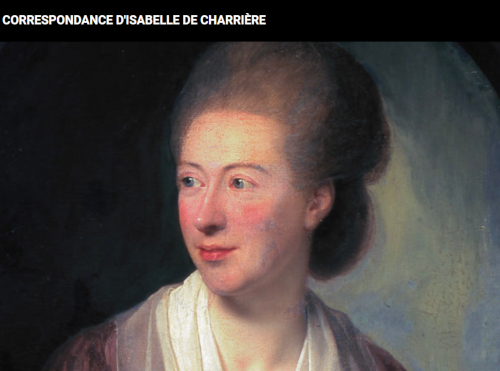A presentation of the Correspondance d’Isabelle de Charrière / Brieven van Belle van Zuylen took place on Saturday, 26 October at the Utrecht Archives (Het Utrechts Archief). The novelist, essayist, and composer known within the Netherlands as Belle van Zuylen and elsewhere as Isabelle de Charrière (1740–1805) is regarded today as a leading light in the Utrecht literary canon. This reputation is due in no small measure to van Zuylen/de Charrière’s correspondence of which approximately 2,600 letters, written in French, survive.
With different sections of the correspondence available hitherto only in Dutch, English, or Japanese translation, and with interest in the writer generating Wikipedia pages in no less than twenty-five different languages, a project team at the Huygens Institute for the History of the Netherlands [KNAW] has come together under the direction of Suzan van Dijk (Huygens ING) and Madeleine van Strien-Chardonneau (Leiden University) to digitize the surviving correspondence. This project has set out to publish a complete digital edition of the letters, and intends to mount transcriptions of the original French alongside manuscript images as well as, in the fullness of time, to add translations.
Over the past couple of years, members of the Belle van Zuylen Association have been working in eLaborate, a tool developed at HuygensING, to create transcriptions. Taking as their starting point the authoritative print edition (Oeuvres complètes, edited by Van Oorschot and published in 1979–84), spellings have been standardized, the layout adapted, and the text annotated. The transcriptions are scheduled to be released online incrementally, and the event at the Utrecht Archives celebrated the release of the first batch of 199 letters, the manuscripts of which reside in the care of archives and libraries in the Netherlands—the National Archives, the Dutch National Library, and Museum of Dutch Literature (The Hague), Archives of the Province of Gelderland (Arnhem), and the Utrecht Archives.
The event included a symposium at which Belle van Zuylen/Isabelle de Charrière, her work, and her importance within the field of cultural history, as well as her subsequent reputation and legacy, were discussed. Kaj van Vliet (archivist, Utrecht Archives) considered the roles played by both van Zuylen/de Charrière and her seventeenth-century predecessor Anna Maria van Schurman with reference to the new exhibition currently on display in the same building. Suzan van Dijk examined the writer’s oft-quoted words: ‘Je n’ai pas les talents subalternes’ (I have no talent for subordination), and revealed that in the letters she had studied in the Dutch archives (the majority of which are addressed to members of van Zuylen’s Dutch aristocratic family) this characteristic was not on display, a fact which reveals an infinitely more interesting and complex personality. Kees van Strien, who has just brought out his latest book Belle van Zuylen. Een leven in Holland (Belle van Zuylen: A life in Holland), spoke about Gijsbert Jan van Hardenbroek, a member of an influential Utrecht family, as well as several of his friends and contemporaries. The private documents of this circle are housed today at the Utrecht Archives, and were published by Van Strien in 2005; on the basis of these letters and diaries, Van Strien considers Hardenbroek as having lost his heart to Van Zuylen and fallen ‘victim to Cupid’. Dirk van Miert (director of the SKILLNET project at Utrecht University) presented the writer as a citizen of the eighteenth-century Republic of Letters, comparing her to Dutch female contemporaries Hyleke Gockinga and Etta Palm: Gockinga was seen as a ‘second Schurman’ on account of her linguistic skills; Palm corresponded with a number of politicians belonging to Van Zuylen’s extended circle, and the two women are likely to have encountered each other in Paris, where Van Zuylen/de Charrière became aware of Palm’s reputation, refering to her as ‘cette intrigante hollandaise’. Josephine Rombouts (author of Cliffrock Castle) recalled the strong impression made upon her (at the age of nineteen when she moved from home to begin university) by Belle van Zuylen, and the opening sentences of the first letter sent by Van Zuylen to D’Hermenches were central in her talk.
The digital edition Correspondance d’Isabelle de Charrière/Brieven van Belle van Zuylen is being released as a ‘work-in-progress’. Letters from the Dutch archives constitute only a small percentage of Van Zuylen/de Charrière’s surviving correspondence, and the focus at this point is to complete the considerable work conducted already on the letters to be found in the Swiss archives. In due course an inventory of the letters will be added to Early Modern Letters Online where it will be searchable both as part of Women’s Early Modern Letters Online and within the entire union catalogue. For those with a particular interest in early modern women’s writing, or in French literature, the Correspondance d’Isabelle de Charrière / Brieven van Belle van Zuylen project is keen to involve additional volunteers, and anyone interested in making a contribution is welcome to contact Suzan van Dijk (suzan.van.dijk@huygens.knaw.nl) or Madeleine van Strien-Chardonneau (madeleinevanstrien@yahoo.fr).


